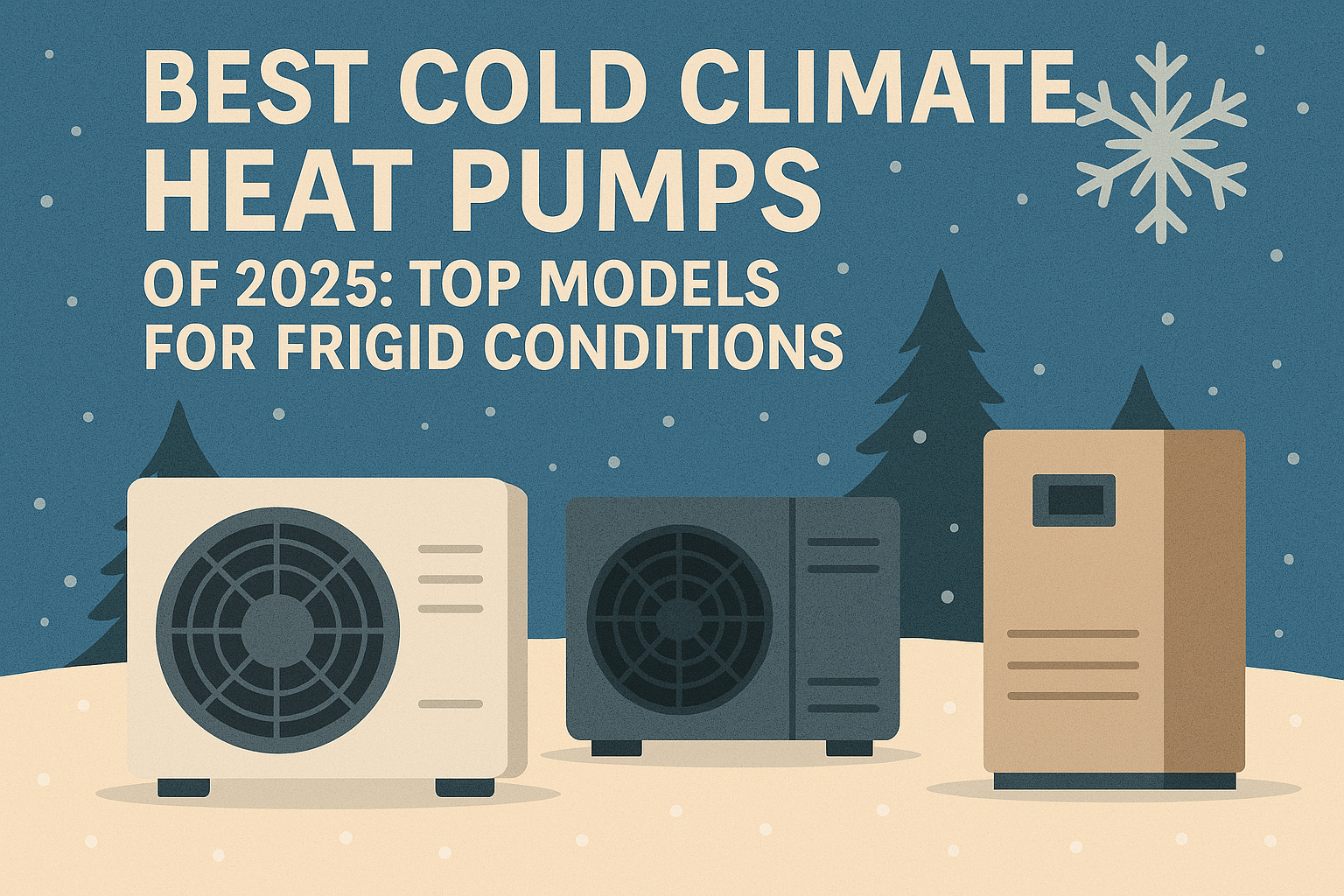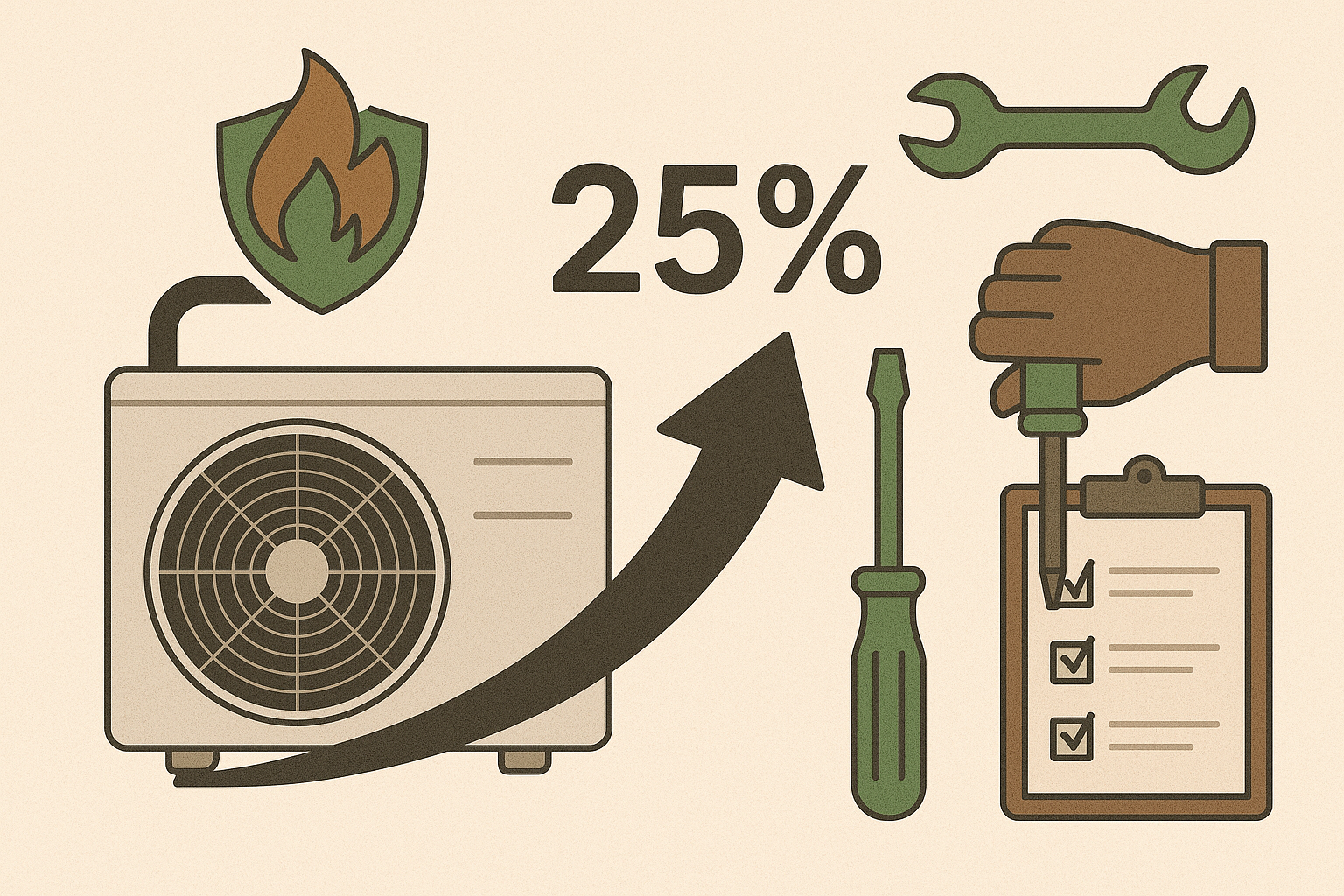The Complete Guide to Cold Climate Heat Pumps: Staying Warm While Saving Money
As winter temperatures plunge across many regions of the United States, homeowners are increasingly looking for efficient, cost-effective heating solutions that can handle frigid conditions. Cold climate heat pumps have emerged as a powerful answer to this challenge, offering remarkable efficiency even in sub-zero temperatures. This comprehensive guide explores everything you need to know about cold climate heat pumps in 2025, from the best models on the market to installation considerations and financial incentives.
What Makes a Heat Pump "Cold Climate" Ready?
Not all heat pumps are created equal when it comes to cold weather performance. Standard heat pumps typically struggle when outdoor temperatures drop below freezing, but cold climate heat pumps are specifically engineered to maintain efficiency and heating capacity in frigid conditions.
Key Features of Cold Climate Heat Pumps
Cold climate heat pumps differ from standard models in several important ways:
- Enhanced low-temperature performance: Can maintain heating capacity down to 5°F or lower
- Operational range: Capable of producing useful heat at temperatures as low as -13°F to -23°F
- Higher coefficients of performance (COP): Maintain efficiency ratios of 2.0 or higher even at low temperatures
- Variable-speed technology: Adjusts output based on conditions for optimal efficiency
- Advanced defrost cycles: Prevents ice buildup on outdoor units during freezing conditions
- Vapor injection technology: Allows for more refrigerant flow in cold conditions
- Improved compressor design: Handles colder operating conditions without strain
Top Cold Climate Heat Pump Brands and Models in 2025
Based on extensive research, contractor interviews, and real-world performance data, these manufacturers stand out for their exceptional cold climate heat pump technology:
Mitsubishi Hyper-Heating (H2i)
Mitsubishi's Hyper-Heating (H2i) technology has established itself as the industry leader for cold climate performance. Available in both M-Series and P-Series for residential installation, these systems offer:
- Full heating capacity maintained down to 5°F
- Useful heat production down to -13°F
- HSPF ratings (heating efficiency) from 10.5 to 12
- SEER ratings (cooling efficiency) of 15 to 20
- Coefficients of performance (COP) as high as 2.88 at 5°F
- Available in both ducted and ductless configurations
Mitsubishi's reputation for reliability and widespread installer network make them a top choice for homeowners in the coldest regions.
Fujitsu AOU Series
Fujitsu's cold climate heat pumps (AOU series) deliver impressive performance in frigid conditions:
- 75-95% of rated heating capacity maintained at 5°F
- Operational down to -10°F
- HSPF ratings from 9.5 to 11.5
- SEER ratings from 16.5 to 20
- Strong contractor support and training programs
- Competitive pricing compared to other premium brands
Contractors frequently mention Fujitsu as a strong alternative to Mitsubishi, with the two brands often trading places in cold climate heat pump rankings.
Daikin Fit and Aurora Lines
Daikin has made significant strides in cold climate technology with their Fit and Aurora product lines:
- Fit (RZQ) line maintains full heating capacity down to 5°F and operates to -4°F
- Aurora (RXL) series functions down to -13°F
- HSPF ratings between 9 and 10.5
- SEER ratings between 16 and 18.5
- Compact outdoor units ideal for homes with space constraints
- Growing installer network across cold climate regions
New DOE Cold Climate Heat Pump Challenge Winners
Several manufacturers have recently passed the U.S. Department of Energy's Cold Climate Heat Pump Challenge, with models becoming available in late 2024 and throughout 2025:
- Carrier's Infinity cold-climate heat pump
- Lennox's Dave Lennox Signature Collection SL22KLV Cold-Climate Heat Pump
- Bosch IDS Ultra (already available for sale)
- LG's Residential Cold Climate Heat Pump (winner of 2025 AHR Innovation Award)
These new models are designed to operate as efficiently at 5°F as they do at 47°F and can function in temperatures as low as -15°F.
How Cold Climate Heat Pumps Overcome Freezing Temperatures
Cold climate heat pumps employ several advanced technologies to maintain performance when temperatures plummet:
Vapor Injection Technology
This technology allows the heat pump to use more refrigerant at once, moving more energy even in cold conditions. It's similar to supercharging a car engine, providing a boost when conditions demand more power.
Variable Speed Compressors
Unlike single-stage compressors that are either on or off, variable speed compressors can adjust their output based on conditions. In colder temperatures, they can cycle refrigerant more quickly and efficiently.
Advanced Refrigerants
Newer refrigerant formulations perform better at lower temperatures, allowing for more efficient heat transfer even when it's frigid outside.
Enhanced Defrost Cycles
Intelligent defrost cycles prevent ice buildup on the outdoor coil without wasting energy, ensuring continuous operation in freezing conditions.
Proper Sizing: The Most Critical Factor for Cold Climate Success
While choosing a quality brand is important, proper system sizing is arguably even more critical for cold climate heat pump performance.
Why Correct Sizing Matters
Heat pumps produce different amounts of heat depending on the outdoor temperature. As temperatures drop, so does the heat pump's capacity. If your system isn't properly sized for your home's heating load on the coldest days, you'll experience comfort issues and potentially strain your system.
The Dangers of Oversizing
Counterintuitively, an oversized heat pump can actually perform worse than a properly sized one. Oversized systems will:
- Cycle on and off more frequently (short-cycling)
- Create temperature fluctuations and discomfort
- Wear out components faster
- Use more energy than necessary
- Provide less effective dehumidification in cooling mode
Professional Load Calculations
A qualified heat pump installer should perform a detailed heating load calculation based on:
- Your home's square footage
- Insulation levels
- Window quality and quantity
- Air leakage rates
- Local climate data
- Design temperatures for your region
This calculation will determine the exact capacity needed for your specific home, ensuring optimal performance even on the coldest days.
Installation Considerations for Cold Climate Heat Pumps
Proper installation is just as important as choosing the right equipment. Here are key considerations for cold climate installations:
Outdoor Unit Placement
- Install at least 2-3 feet above the maximum expected snow level
- Ensure proper clearances around the unit for airflow
- Position away from roof drip lines to prevent ice formation
- Consider wind exposure and protection
- Install on a stable pad or wall-mounted bracket
Indoor Considerations
- Proper ductwork sizing for ducted systems
- Strategic placement of indoor heads for ductless systems
- Adequate condensate drainage with freeze protection
- Accessible filter locations for easy maintenance
- Proper refrigerant line insulation and sealing
Backup Heating Options
In extremely cold regions, consider backup heating options:
- Electric resistance backup (integrated in many systems)
- Dual-fuel systems with existing furnace as backup
- Properly sized backup for the percentage of heating load at extreme temperatures
Real-World Performance and User Experiences
Heat pumps don't just work well on paper—they're proving themselves in some of the coldest regions of the United States. Data from the Massachusetts Clean Energy Center shows thousands of successful installations across the state, where winter temperatures frequently drop below 0°F.
Homeowner experiences highlight several common themes:
- Consistent comfort even during cold snaps
- Significant energy savings compared to oil, propane, or electric resistance heating
- Appreciation for the added cooling capability in summer
- Initial skepticism followed by satisfaction with performance
- Importance of working with experienced installers
Financial Incentives for Cold Climate Heat Pumps in 2025
The financial case for cold climate heat pumps has never been stronger, thanks to substantial incentives at the federal, state, and utility levels:
Federal Tax Credits
- 30% of project costs up to $2,000 through the Energy Efficient Home Improvement Credit
- Available for qualifying systems through 2032
- No lifetime limit—can be claimed annually for different properties or new installations
State and Utility Rebates
Many states and utilities offer additional incentives specifically for cold climate heat pumps:
- Direct rebates ranging from $500 to $10,000 depending on location and system type
- Income-based rebates up to $8,000 through the Home Electrification and Appliance Rebates (HEAR) program
- Performance-based incentives in some regions
- Additional incentives for whole-home electrification projects
Operational Savings
Beyond incentives, cold climate heat pumps typically deliver substantial operational savings:
- 30-60% reduction in heating costs compared to oil, propane, or electric resistance heating
- Additional savings from cooling efficiency in summer
- Potential for further savings when paired with solar panels
Maintenance Tips for Cold Climate Heat Pumps
To ensure your cold climate heat pump continues to perform optimally through harsh winters:
Regular Maintenance Tasks
- Keep the outdoor unit clear of snow and ice
- Clean or replace air filters monthly during heavy use
- Ensure outdoor coils are clean and free of debris
- Maintain proper clearances around the outdoor unit year-round
- Schedule professional maintenance annually before heating season
Winter Operation Best Practices
- Avoid frequent temperature adjustments—set it and forget it
- Use "heat" mode rather than "auto" mode in winter
- Don't panic if you see steam during defrost cycles—this is normal
- Consider a protective cover for the top of the outdoor unit (never fully cover the sides)
- Monitor performance during extreme cold events
Is a Cold Climate Heat Pump Right for Your Home?
While cold climate heat pumps offer impressive performance, they're not automatically the best choice for every home. Consider these factors when deciding:
Ideal Candidates for Cold Climate Heat Pumps
- Homes in regions with electricity prices lower than oil or propane costs
- Well-insulated homes with moderate heating loads
- Homeowners looking to reduce carbon footprint
- Homes needing both heating and cooling solutions
- Properties with existing ductwork or suitable for ductless installation
Situations Where Alternatives Might Be Better
- Extremely poorly insulated homes with very high heating loads
- Regions with exceptionally low natural gas prices compared to electricity
- Historic homes with preservation restrictions
- Homes with no existing cooling need and very low-cost heating
Conclusion
Cold climate heat pumps have revolutionized heating options for homeowners in frigid regions, offering unprecedented efficiency, comfort, and environmental benefits. With continued technological advancements, substantial financial incentives, and growing installer expertise, 2025 represents an ideal time to consider this technology for your home.
The key to success lies in choosing a quality system from a reputable manufacturer, ensuring proper sizing through professional load calculations, and working with experienced installers familiar with cold climate applications. When these elements come together, even homeowners in the coldest regions can enjoy comfortable, efficient, and environmentally friendly heating all winter long.
FAQs About Cold Climate Heat Pumps
Q: At what temperature do cold climate heat pumps stop working? A: Top cold climate heat pumps can produce heat at temperatures as low as -13°F to -23°F, though efficiency decreases at extreme temperatures.
Q: Do I need backup heat with a cold climate heat pump? A: It depends on your climate and comfort requirements. In regions that rarely see temperatures below -10°F, a properly sized cold climate heat pump may not need backup. For extremely cold regions, backup heating provides peace of mind.
Q: How much can I save with a cold climate heat pump? A: Savings vary based on your current heating system, local energy prices, and climate. Many homeowners report 30-60% savings compared to oil, propane, or electric resistance heating.
Q: How loud are cold climate heat pumps? A: Modern cold climate heat pumps operate at around 55-65 decibels outdoors (similar to normal conversation) and as low as 20-30 decibels indoors (quieter than a whisper).
Q: Can cold climate heat pumps provide air conditioning too? A: Yes, all cold climate heat pumps provide both heating and cooling, making them a versatile year-round comfort solution.
Q: How long do cold climate heat pumps last? A: With proper maintenance, expect 15+ years of service, though many systems continue to operate efficiently for 20+ years.
This article is for informational purposes only and does not constitute professional advice. Consult with qualified HVAC professionals regarding your specific home heating needs and local climate conditions.

